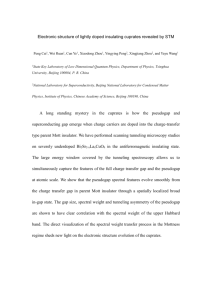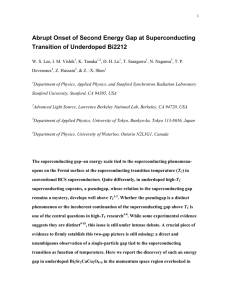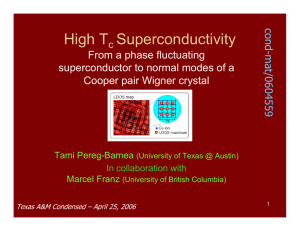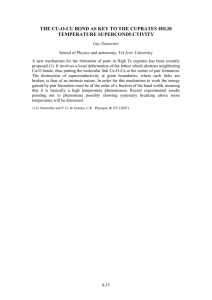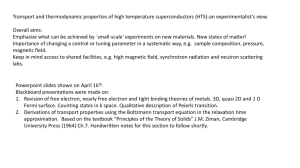Spectroscopic signatures of two energy scales in superconducting
advertisement
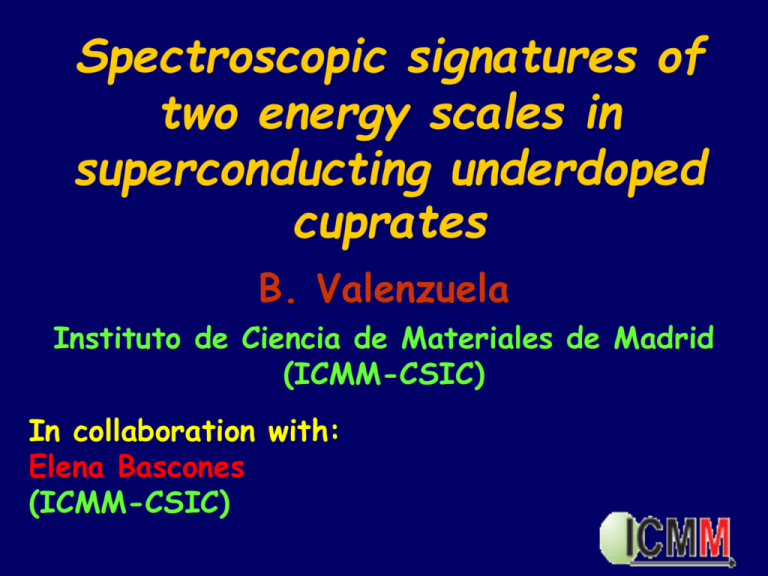
Spectroscopic signatures of two energy scales in superconducting underdoped cuprates B. Valenzuela Instituto de Ciencia de Materiales de Madrid (ICMM-CSIC) In collaboration with: Elena Bascones (ICMM-CSIC) Outline • Conventional superconducting phase in high Tc superconductors? •Experimental evidence in ARPES and Raman of deviation from d-wave BCS in superconducting underdoped cuprates: two-scales •Introduction to the phenomenological model proposed to describe the pseudogap (Yang, Rice & Zhang ‘06) •Results on how two energy scales appear in underdoped superconducting cuprates in ARPES, autocorrelated ARPES and Raman. Pseudogap State: Fermi arcs and Nodal-Antinodal Dichotomy Antinodal region Nodal region Shen et al, Science 307, 901 (2005) Superconducting phase Conventional BCS d-wave superconductivity? Recently nodalantinodal dichotomy has also been observed in underdoped Scenarios for the High-Tc cuprates QCP at xc Standard BCS xc Pseudogap and superconductivity have a common origin Pseudogap and superconductivity are different instabilities which compete d-wave BCS superconductor: BCS: E(k ) ( (k ) S (k ))1/ 2 2 2 d-wave: S (k ) S (cos k x cos k y ) S cos( 2 ) d-wave BCS: A single energy scale s E Gap depends linearly on cos(2): V-shape coskx-cosky Nodal velocity v=1/2(ds()/d)|=p/4=s Antinodal gap, max=s(=p/2)=s ARPES deviations from d-wave BCS in Underdoped SC Cuprates U-shape K. Tanaka et al, Science 314, 1910 (2006) Two scales in Energy spectrum with underdoping v decreases max increases Two energy scales in Raman Spectrum in the SC State of Underdoped Cuprates Energy scale of peak in antinodal (nodal) region increases (decreases) with decreasing doping in underdoped cuprates. Pair breaking peak intensity decreases with underdoping in antinodal region (opposite behavior expected from increasing energy scale) Le Tacon et al, Nat. Phys. 2, 537 (2006) Evolution of Nodal and Antinodal energy scales with x Le Tacon et al, Nat. Phys. 2, 537 (2006) Energy Evolution of Nodal and Antinodal energy scales with x 2 2 Doping BV and E. Bascones PRl 98, 227002 (2007) Also able to reproduce the decrease in intensity of antinodal Raman peak with underdoping Phenomenological model for doped spin liquid+QCP to describe the pseudogap state Coherent + Incoherent part G RVB gt (k , ) (k ) R (k , ) Only diagonal 0 (k ) 2t ( x)(cos k x cos k y ) (k) 0 (/2 k ) 2t ' ( x) cos k x cos k y 2t ' ' ( x)(cos 2k x cos 2k y ) R (k , ) 2R ( x) /( 0 (k )) R (k ) R ( x)(cos k x cos k y ) gt ( x) 2 x /(1 x) Yang, Rice,Zhang PRB 73, 174501 (2006) QC “Gapless Fermi arcs” X=0.05 X=0.14 ky ky ky E coskx-cosky kx kx kx E X=0.20 E coskx-cosky coskx-cosky Doped spin liquid in the SC State G (k , ) g t / k R (k , ) S (k ) /( R (k , )) YRZ SC 2 X=0.10 Pseudogap physics (and scale R) present, if x<xc, in SC state X=0.14 X=0.18 X=0.20 Four bands with energies ±E± for x<xc X=0.25 Two scales in the Raman spectra BV and E. Bascones PRl 98, 227002 (2007) X=0.10 X=0.14 X=0.18 X=0.20 Antinodal (B1g) peak shifts to higher energy and its intensity decreases with underdoping. X=0.10 X=0.14 X=0.18 X=0.20 Nodal (B2g) peak shifts to lower energy with weaker effect on intensity with underdoping. Two pair-breaking transitions below xc BV and E. Bascones PRl 98, 227002 (2007) X=0.10 X=0.14 Pair breaking transitions with energy 2E+ and 2Eappear for x<xc when entering the superconducting state X=0.18 X=0.20 X=0.25 Only one pair breaking transition can be distinguished for x≥xc Two pair-breaking transitions below xc BV and E. Bascones PRl 98, 227002 (2007) X=0.14, E- X=0.14, E+ X=0.20, E-& E+ Gap at the maximum intensity surface: Ushape in ARPES X=0.14 (x<xc) BV and E. Bascones PRl 98, 227002 (2007) X=0.20 (x ≥ xc) E ky E coskx-cosky kx U-shape v decreases max increases with underdoping coskx-cosky ky kx V-shape Single scale v=max The convergence of the two energy scales and the possible phase-diagram scenarios T=0 QCP scenario BV and E. Bascones PRl 98, 227002 (2007) Do not confuse convergence of scales below Tc with convergence of T* and Tc xc Autocorrelation of ARPES data (AC-ARPES) Dispersive peaks in Superconducting State Non-Dispersive peaks in Pseudogap from momenta joining the along tips of the Fermi arcs bond Chatterjee et al, PRL 96, 067005 (2006) Suggest similar origin for dispersive and non-dispersive peaks AC-ARPES in the absence of Pseudogap Correlations (beyond xc) Dispersive peaks in SC State Calculated AC-ARPES spectra EXPERIMENT AC-ARPES in the Pseudogap State (below x ) c along bond EXPERIMENT Chatterjee et al, PRL 96, 067005 (2006) Calculated AC-ARPES spectra 2p 3(2p as origin of ¾ substructure 0 Suggests q*5 E. Bascones and B. V. cond-mat/0702111 q Dispersive and/or nondispersive peaks can appear in the SC state below xc -> confirmed in Chatterjee arXiv:0705.4136 E. Bascones and B. V. cond-mat/0702111 Summary Two energy scales (nodal and antinodal) in the Raman and ARPES spectra appear naturally in some QCP models below xc With the YRZ Green’s function scenario v is a good measure of the superconducting order parameter In this picture the suppression of intensity in B1g channel with underdoping is a consequence of the competition between pseudogap and superconductivity These results suggest that there is a QCP under the superconducting dome in the high-Tc phase diagram Other experiments? Autocorrelated ARPES, Prediction: Dispersive and non dispersive peaks in underdoped SC cuprates ->confirmed in experiments Doping independent slope in B2g at low frequencies X=0.14 X=0.18 X=0.20 BV and E. Bascones PRl 98, 227002 (2007) Le Tacon et al, Nat. Phys. 2, 537 (2006) Hole-doped High-Tc Superconductors Cu O Norman et al, Nature 392, 157 (1998) X=0 (undoped) Mott insulator Optimally doped (Highest Tc) (added holes per Cu ion) Overdoped How to fulfill Luttinger sum rule? X=0.05 X=0.18 X=0.10 Luttinger surface X=0.14 X=0.20 Yang, Rice,Zhang PRB 73, 174501 (2006) Hole pockets Topological QCP A third “crossing” transition is expected below xc Superconducting state X=0.14 BV and E. Bascones PRl 98, 227002 (2007) A transition with energy E-+E+ is expected in both superconducting and pseudogap states Pseudogap state X=0.14 Small effect of this transition in the subtracted response Total Raman response in the SC state BV and E. Bascones PRl 98, 227002 (2007) The crossing transition is hardly distinguished in the superconducting state And what else? BV and E. Bascones PRl 98, 227002 (2007) B1g: antinodal region participates in superconductivity. What about QCP models with symmetry-breaking? Not absolutely ruled out by these experiments but work worse and no clear evidence of phase transition from other measurements. Pseudogap without long-range, hole pockets, Luttinger surface, QCP, two gaps in the SC state and v ~S also in cellular DMFT
